Volans constellation lies in the southern sky. It is one of the smallest constellations. It represents the flying fish.
Volans is not associated with any myths. It was one of the constellations created by the Dutch astronomer and cartographer Petrus Plancius in the late 16th century that first appeared depicted in a star atlas in 1603, in Johann Bayer’s Uranometria. The constellation was originally named Piscis Volans, the flying fish, by Plancius, but the name was eventually shortened to Volans.
Volans contains several notable deep sky objects, among them the Lindsay-Shapley Ring (AM0644-741), the Meathook Galaxy (NGC 2442), the spiral galaxy NGC 2397, and the galaxy cluster SMACS 0723, one of the first targets of NASA’s James Webb Space Telescope (JWST).
Facts, location and map
Volans is the 76th constellation in size, occupying an area of 141 square degrees. It is located in the second quadrant of the southern sky (SQ2) and can be seen at latitudes between +15° and -90°. The neighboring constellations are Carina, Chamaeleon, Dorado, Mensa and Pictor.
The constellation name Volans is pronounced /ˈvoʊlænz/. In English, the constellation is known as the Flying Fish. The genitive form of Volans, used in star names, is Volantis (pronunciation: /voʊˈlæntɪs/). The three-letter abbreviation, adopted by the International Astronomical Union (IAU) in 1922, is Vol.
Volans belongs to the Johann Bayer family of constellations, along with Apus, Chamaeleon, Dorado, Grus, Hydrus, Indus, Musca, Pavo, Phoenix and Tucana.
Volans contains one named star, Maru (WD 0806-661).
Volans contains two stars with confirmed planets and does not have any Messier objects. The brightest star in the constellation is Beta Volantis, with an apparent magnitude of 3.77. There are no meteor showers associated with the constellation.
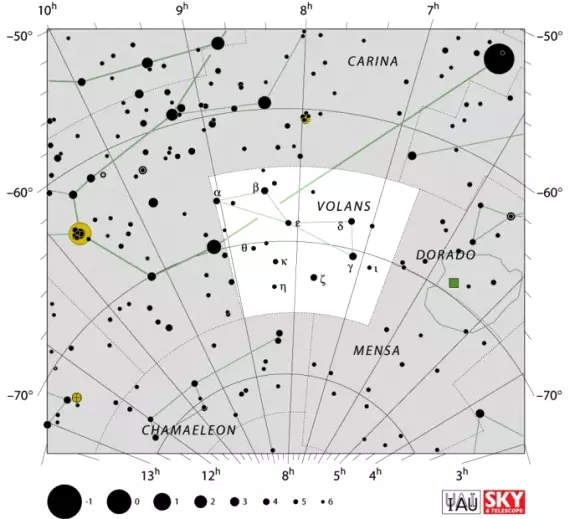
Volans constellation map by IAU and Sky&Telescope magazine
Story
Volans is one of the 12 constellations that were introduced by the Dutch navigators Pieter Dirkszoon Keyser and Frederick de Houtman in the late 16th century. It was first depicted on Petrus Plancius’ globe in 1598. Plancius called the constellation Vliegendenvis.
In 1603, Johann Bayer included the constellation in his star atlas Uranometria under the name Piscis Volans, the flying fish. It was known by that name until the mid-19th century. It was John Herschel who suggested that the name be shortened to just Volans.
In 1845, Francis Baily included the constellation in his British Association Catalogue as Volans and the name has stuck ever since.
Volans represents a type of tropical fish that can jump out of the water and glide through the air on wings. In the sky, the flying fish is often depicted as being chased by the predatory fish represented by Dorado constellation.
Major stars in Volans
β Volantis (Beta Volantis)
Beta Volantis is the brightest star in Volans constellation. It has an apparent magnitude of 3.77 and is 107.5 light years distant from the Sun. It is an orange giant with the stellar classification K1III. It has 1.62 solar masses and is 41 times more luminous than the Sun.
γ Volantis (Gamma Volantis)
Gamma Volantis is a binary star in Volans, located about 142 light years from the Sun. The system is composed of the primary component, Gamma-2 Volantis, an orange giant with the stellar classification K0III, and Gamma-1 Volantis, a yellow-white main sequence star belonging to the stellar class F2V. Gamma-2 Volantis has an apparent magnitude of 3.78 and Gamma-1 has a visual magnitude of 5.68. The two stars are separated by 14.1 seconds of arc in the sky.
ζ Volantis (Zeta Volantis)
Zeta Volantis is another binary star in Volans. It has an apparent magnitude of 3.93 and is approximately 134 light years distant. The system consists of an orange giant belonging to the spectral class K0III and a 10th magnitude companion. The stars are separated by 16.7 arc seconds.
δ Volantis (Delta Volantis)
Delta Volantis is a yellow-white bright giant star with the stellar classification F6II. It has an apparent magnitude of 3.97 and is approximately 660 light years distant from the Sun.
α Volantis (Alpha Volantis)
Alpha Volantis is an Am star (metallic line star), which means that it is A-type chemically peculiar star with a strong spectrum and variable absorption lines of metals. It has the stellar classification of kA3hA5mA5 V. The star has an apparent magnitude of 4.00 and is approximately 125 light years distant from Earth. It is believed to be about 427 million years old.
ε Volantis (Epsilon Volantis)
Epsilon Volantis is a triple star system about 642 light years away in Volans constellation. It has an apparent magnitude of 4.35.
The primary component in the system is a blue-white subgiant with the stellar classification of B6IV. It is a spectroscopic binary star with an orbital period of 14.17 days. The binary system has a companion with a visual magnitude of 8.1 located 6.05 arc seconds away.
θ Volantis (Theta Volantis)
Theta Volantis is a white main sequence star with the stellar classification A0V. It has an apparent magnitude of 5.19 and is approximately 239 light years distant from the Sun.
η Volantis (Eta Volantis)
Eta Volantis is another triple star system in Volans. It has an apparent magnitude of 5.28 and is approximately 356 light years distant from Earth.
The primary component in the system is a white subgiant of the spectral type A. The star has two 12th magnitude companions located 30.8 and 42.4 arc seconds away.
κ Volantis (Kappa Volantis)
Kappa Volantis is another triple star system in Volans, about 393 light years distant from the Sun. The system is composed of a blue-white giant with the stellar classification of B9III-IV and a visual magnitude of 5.33, a white subgiant belonging to the stellar class A0IVMn with an apparent magnitude of 5.63, and a star with a magnitude of 8.5 separated from the second component by 37.7 arc seconds. Kappa-1 Volantis and Kappa-2 Volantis are separated by 65 seconds of arc.
ι Volantis (Iota Volantis)
Iota Volantis is a blue-white subgiant star with the stellar classification of B7IV. It has an apparent magnitude of 5.41 and is approximately 558 light years distant from the solar system.
HD 76700
HD 76700 is a yellow dwarf with the stellar classification G6V. It has an apparent magnitude of 8.13 and is 194.6 light years distant from Earth. The star has a mass similar to the Sun, but is much brighter and older.
A planet was recently discovered orbiting the star with a period of 3.97097 days. It has a mass 0.233 times that of Jupiter.
Deep sky objects in Volans
NGC 2397
NGC 2397 is a spiral galaxy in Volans. It has an apparent magnitude of 12.68 and is approximately 60 million light years distant. The galaxy’s nucleus contains old red and yellow stars, and the outer spiral arms are regions where star formation has recently taken place.
The galaxy was discovered by the English astronomer and mathematician John Herschel on February 21, 1835. A late stage supernova, SN 2006bc, was discovered in NGC 2397 in 2006.
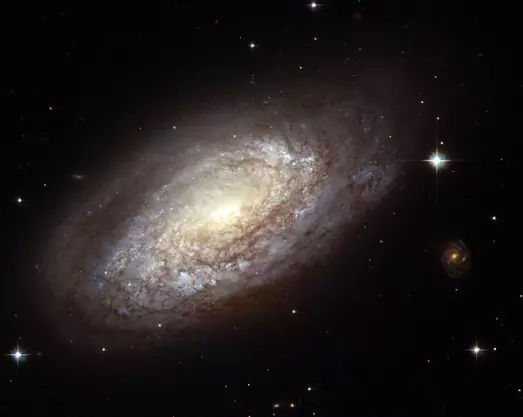
The spiral galaxy NGC 2397 as photographed by the Hubble Space Telescope. Image: NASA, ESA & Stephen Smartt (Queen’s University Belfast, UK)
Lindsay-Shapley Ring – AM0644-741
AM0644-741 is an unbarred lenticular galaxy in Volans. It has an apparent magnitude of 13.96 and is approximately 300 million light years distant from Earth.
The ring surrounding the galaxy’s nucleus is about 150,000 light years in diameter. The ring is believed to have formed after a collision with another galaxy, which caused the dust in AM0644-741 to condense and begin to form stars, and then to expand away from the galaxy and form a ring.
The ring is a starburst region and contains many hot blue stars. It will likely continue to expand for another 300 million years, and then begin to disintegrate.
The galaxy was discovered by Eric Lindsay and Harlow Shapley in 1960. It is situated near the Large Magellanic Cloud, which is located in the constellations Mensa and Dorado.
AM0644-741 was later identified as a peculiar southern ring galaxy by the astronomer John A. Graham, and is sometimes also known as Graham’s Ring Galaxy.
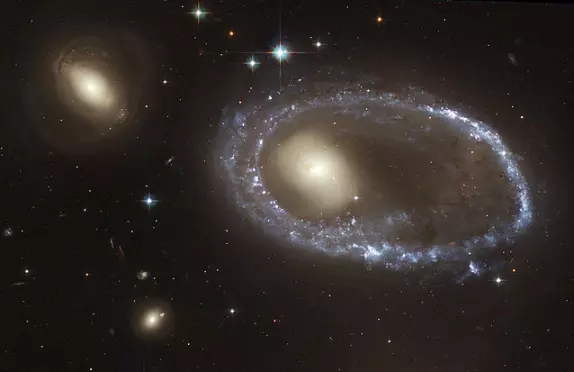
The sparkling blue ring, around the yellowish nucleus of what was once a normal spiral galaxy, is 150,000 light-years in diameter, making it larger than our entire home galaxy, the Milky Way. The galaxy, cataloged as AM 0644-741, is a member of the class of so-called ring galaxies. It lies 300 million light-years away in the direction of the southern constellation Dorado. Image: NASA, ESA, and the Hubble Heritage Team (AURA, STScI)
Meathook Galaxy (NGC 2442 and NGC 2443)
NGC 2442 is an intermediate spiral galaxy in Volans. It was discovered by John Herschel, who described one of the galaxy’s spiral arms as hook-like. The galaxy’s distorted appearance is believed to be the result of an encounter with a smaller galaxy.
The galaxy has a visual magnitude of 11.2 and is approximately 50 million light years distant from Earth. Its visible disk and spiral arms span approximately 150,000 light years.
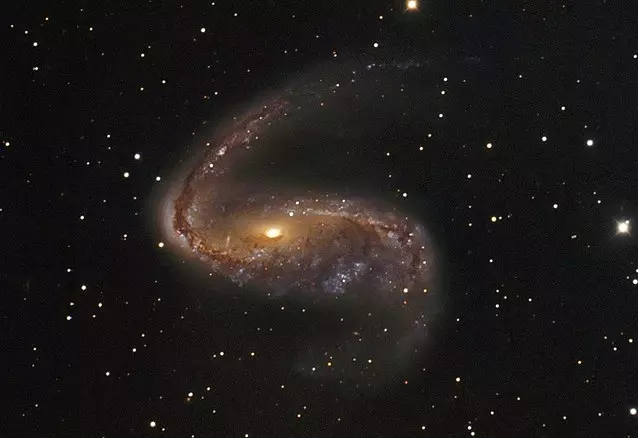
The distorted galaxy NGC 2442, also known as the Meathook Galaxy, is located about 50 million light-years away in the constellation of Volans (the Flying Fish). The galaxy is 75 000 light-years wide and features two dusty spiral arms extending from a pronounced central bar that give it a hook-like appearance, hence its nickname. The galaxy’s distorted shape is most likely the result of a close encounter with a smaller, unseen galaxy. Image: ESO, IDA, Danish 1.5 m, R. Gendler, J.-E. Ovaldsen, C. C. Thöne and C. Féron
SMACS 0723
SMACS 0723 (SMACS J0723.3-7327) is a massive galaxy cluster that acts as a gravitational lens for distant background galaxies. It was one of the first targets of the James Webb Space Telescope (JWST) in 2022. The deep field view of the cluster reveals some of the faintest deep sky objects ever observed in infrared. The cluster lies approximately 4.24 billion light-years away.
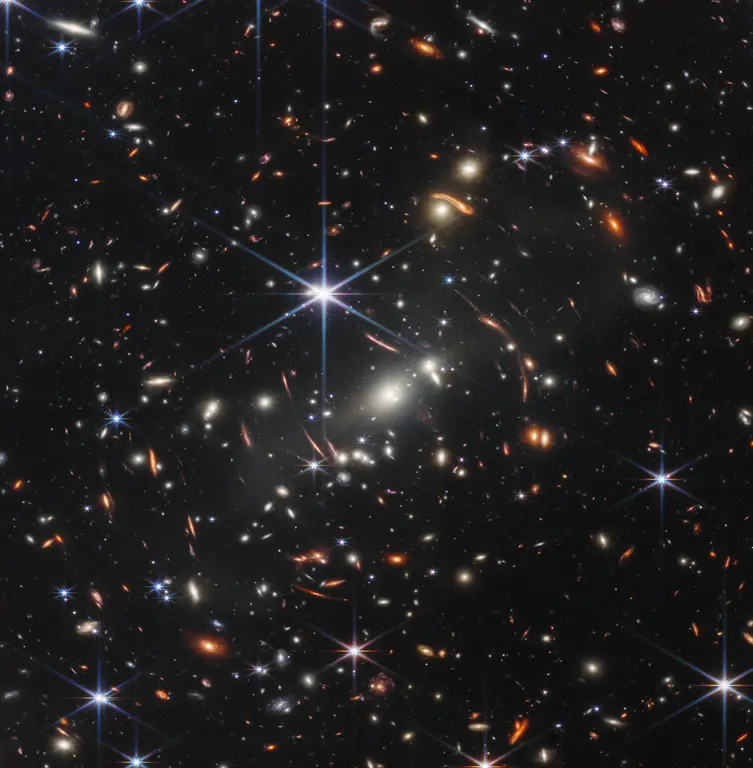
James Webb Telescope’s first deep field, credit: NASA, ESA, CSA, and STScI
NGC 2434
NGC 2434 is an elliptical galaxy in Volans. It has a visual magnitude of 11.3 and is 21,898 Mpc distant. The galaxy was discovered by John Herschel on December 23, 1834.